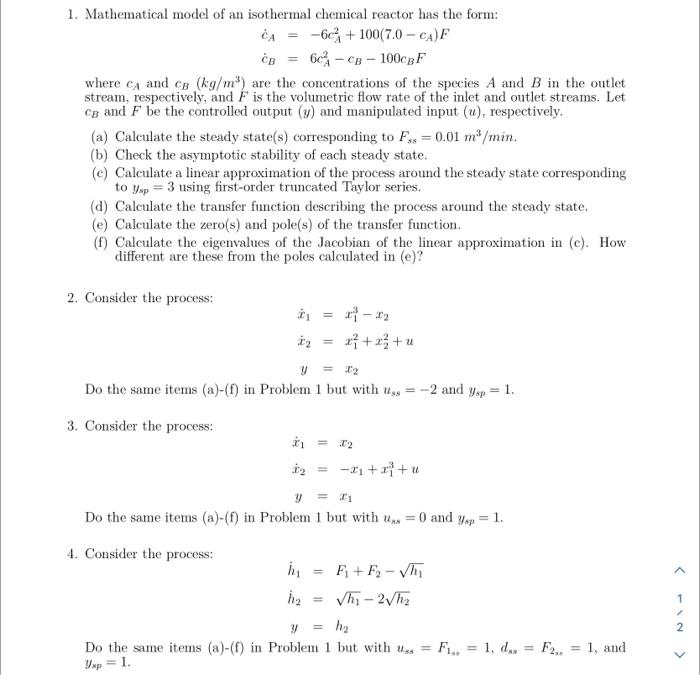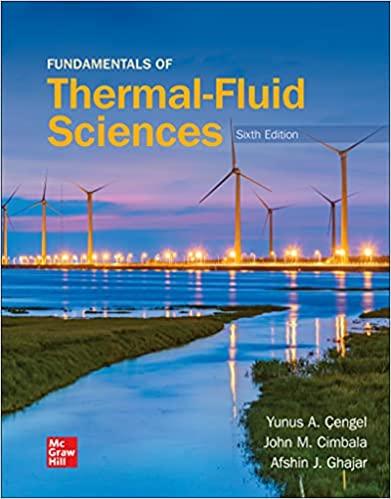Answered step by step
Verified Expert Solution
Question
1 Approved Answer
Process control 1. Mathematical model of an isothermal chemical reactor has the form: cA=6cA2+100(7.0cA)FcB=6cA2cB100cBF where cA and cB(kg/m3) are the concentrations of the species A
Process control 
1. Mathematical model of an isothermal chemical reactor has the form: cA=6cA2+100(7.0cA)FcB=6cA2cB100cBF where cA and cB(kg/m3) are the concentrations of the species A and B in the outlet stream, respectively, and F is the volumetric flow rate of the inlet and outlet streams. Let cB and F be the controlled output (y) and manipulated input (u), respectively. (a) Calculate the steady state(s) corresponding to Fss=0.01m3/min. (b) Check the asymptotic stability of each steady state. (c) Calculate a linear approximation of the process around the steady state corresponding to ysp=3 using first-order truncated Taylor series. (d) Calculate the transfer function describing the process around the steady state. (e) Calculate the zero(s) and pole(s) of the transfer function. (f) Calculate the eigenvalues of the Jacobian of the linear approximation in (c). How different are these from the poles calculated in (e)? 2. Consider the process: x1x2y=x13x2=x12+x22+u=x2 Do the same items (a)-(f) in Problem 1 but with uss=2 and ysp=1. 3. Consider the process: x1x2y=x2=x1+x13+u=x1 Do the same items (a)-(f) in Problem 1 but with uss=0 and ysp=1. 4. Consider the process: h1h2y=F1+F2h1=h12h2=h2 Do the same items (a)-(f) in Problem 1 but with uss=F1ss=1,dss=F2ss=1, and ysp=1. 1. Mathematical model of an isothermal chemical reactor has the form: cA=6cA2+100(7.0cA)FcB=6cA2cB100cBF where cA and cB(kg/m3) are the concentrations of the species A and B in the outlet stream, respectively, and F is the volumetric flow rate of the inlet and outlet streams. Let cB and F be the controlled output (y) and manipulated input (u), respectively. (a) Calculate the steady state(s) corresponding to Fss=0.01m3/min. (b) Check the asymptotic stability of each steady state. (c) Calculate a linear approximation of the process around the steady state corresponding to ysp=3 using first-order truncated Taylor series. (d) Calculate the transfer function describing the process around the steady state. (e) Calculate the zero(s) and pole(s) of the transfer function. (f) Calculate the eigenvalues of the Jacobian of the linear approximation in (c). How different are these from the poles calculated in (e)? 2. Consider the process: x1x2y=x13x2=x12+x22+u=x2 Do the same items (a)-(f) in Problem 1 but with uss=2 and ysp=1. 3. Consider the process: x1x2y=x2=x1+x13+u=x1 Do the same items (a)-(f) in Problem 1 but with uss=0 and ysp=1. 4. Consider the process: h1h2y=F1+F2h1=h12h2=h2 Do the same items (a)-(f) in Problem 1 but with uss=F1ss=1,dss=F2ss=1, and ysp=1 
Step by Step Solution
There are 3 Steps involved in it
Step: 1

Get Instant Access to Expert-Tailored Solutions
See step-by-step solutions with expert insights and AI powered tools for academic success
Step: 2

Step: 3

Ace Your Homework with AI
Get the answers you need in no time with our AI-driven, step-by-step assistance
Get Started


